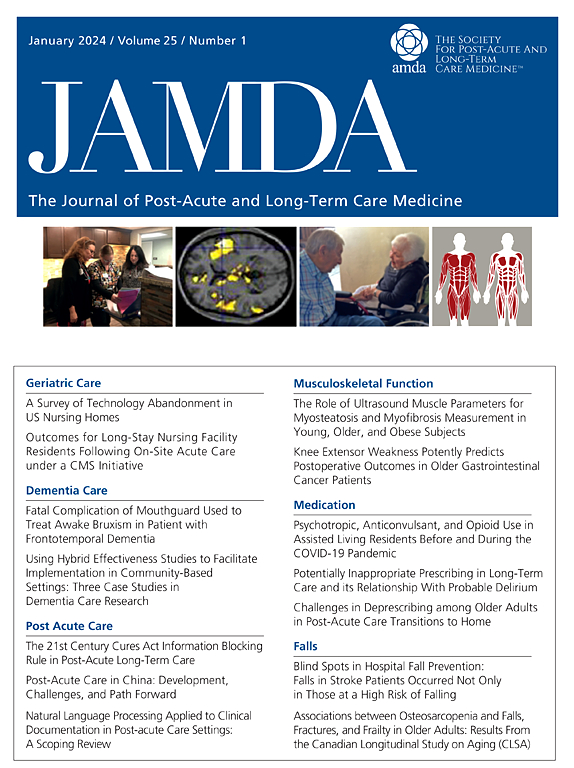Days at Home for Older Adults Receiving a Remote Monitoring Intervention Compared with Usual Home Care Recipients
IF 4.2
2区 医学
Q2 GERIATRICS & GERONTOLOGY
Journal of the American Medical Directors Association
Pub Date : 2025-05-14
DOI:10.1016/j.jamda.2025.105611
引用次数: 0
Abstract
Objectives
Many older adults will experience physical and or cognitive decline, limiting their ability to live independently. To better support these individuals, remote monitoring programs use technology to track patient falls, location, and medication adherence. Our main objective was to compare outcomes of patients enrolled in a remote monitoring program with matched individuals who received home care.
Design
Propensity score–matched cohort study.
Setting and Participants
Toronto, Ontario, Canada. Older adults (aged 65 or older) in a remote monitoring program (N = 1587) compared with a control group of older adults initiating a new episode of home care (N = 33,207).
Methods
The primary outcome was days spent at home in the following 100 days. Additional outcomes included days in different health care settings, days alive, and health care costs.
Results
Before matching, patients enrolled in the remote monitoring program (946 female) were younger [mean (SD) = 80.1 years (8.2) vs 82.4 (8.5), standardized mean difference 0.21] than those in the home care group (20,877 female). After matching, there were 1494 individuals in each group. In the 100 days following the index date, those in the remote monitoring group spent 3.4 more days at home than the home care group (92.3 vs 88.9 days, 95% CI, 1.9–5.0 days; rate ratio, 1.04; 95% CI, 1.02–1.06). This was attributable to more days alive (98.6 vs 96.4 days; 95% CI, 1.3–3.1 days; rate ratio, 1.03; 95% CI, 1.01–1.03). In addition, the remote monitoring group had lower health care costs overall (difference of $1635.54 CAD, 95% CI, $228.83–$3087.11).
Conclusions and Implications
Individuals enrolled in a remote monitoring program spent more days at home compared with those who received home care services, mainly attributed to more days alive. Further study is needed to confirm our findings; however, remote monitoring is a promising solution to support older adults with high care needs.
接受远程监测干预的老年人在家的天数与普通家庭护理接受者的比较
许多老年人会经历身体和/或认知能力下降,限制了他们独立生活的能力。为了更好地支持这些人,远程监控程序使用技术来跟踪患者跌倒、位置和药物依从性。我们的主要目的是比较参加远程监测项目的患者与接受家庭护理的匹配个体的结果。设计倾向评分匹配队列研究。背景和参与者加拿大安大略省多伦多。参加远程监测项目的老年人(65岁或以上)(N = 1587)与开始新的家庭护理的老年人对照组(N = 33,207)进行比较。方法以100 d内的居家天数为主要观察指标。其他结果包括在不同医疗机构的天数、存活天数和医疗费用。结果在配对前,参加远程监测项目的患者(946名女性)比家庭护理组(20,877名女性)年轻[平均(SD) = 80.1岁(8.2岁)vs 82.4岁(8.5岁),标准化平均差0.21]。配对后,每组1494人。在指标日期后的100天内,远程监护组比家庭护理组在家多呆3.4天(92.3天vs 88.9天,95% CI, 1.9-5.0天;比率比,1.04;95% ci, 1.02-1.06)。这可归因于更多的存活天数(98.6 vs 96.4天;95% CI, 1.3-3.1天;比率比,1.03;95% ci, 1.01-1.03)。此外,远程监测组的总体医疗保健费用较低(差异为1635.54加元,95% CI, 228.83 - 3087.11美元)。结论和意义与接受家庭护理服务的个体相比,参加远程监测项目的个体在家里呆的时间更长,主要原因是存活的时间更长。需要进一步的研究来证实我们的发现;然而,远程监控是一个有希望的解决方案,以支持老年人的高护理需求。
本文章由计算机程序翻译,如有差异,请以英文原文为准。
求助全文
约1分钟内获得全文
求助全文
来源期刊
CiteScore
11.10
自引率
6.60%
发文量
472
审稿时长
44 days
期刊介绍:
JAMDA, the official journal of AMDA - The Society for Post-Acute and Long-Term Care Medicine, is a leading peer-reviewed publication that offers practical information and research geared towards healthcare professionals in the post-acute and long-term care fields. It is also a valuable resource for policy-makers, organizational leaders, educators, and advocates.
The journal provides essential information for various healthcare professionals such as medical directors, attending physicians, nurses, consultant pharmacists, geriatric psychiatrists, nurse practitioners, physician assistants, physical and occupational therapists, social workers, and others involved in providing, overseeing, and promoting quality

 求助内容:
求助内容: 应助结果提醒方式:
应助结果提醒方式:


